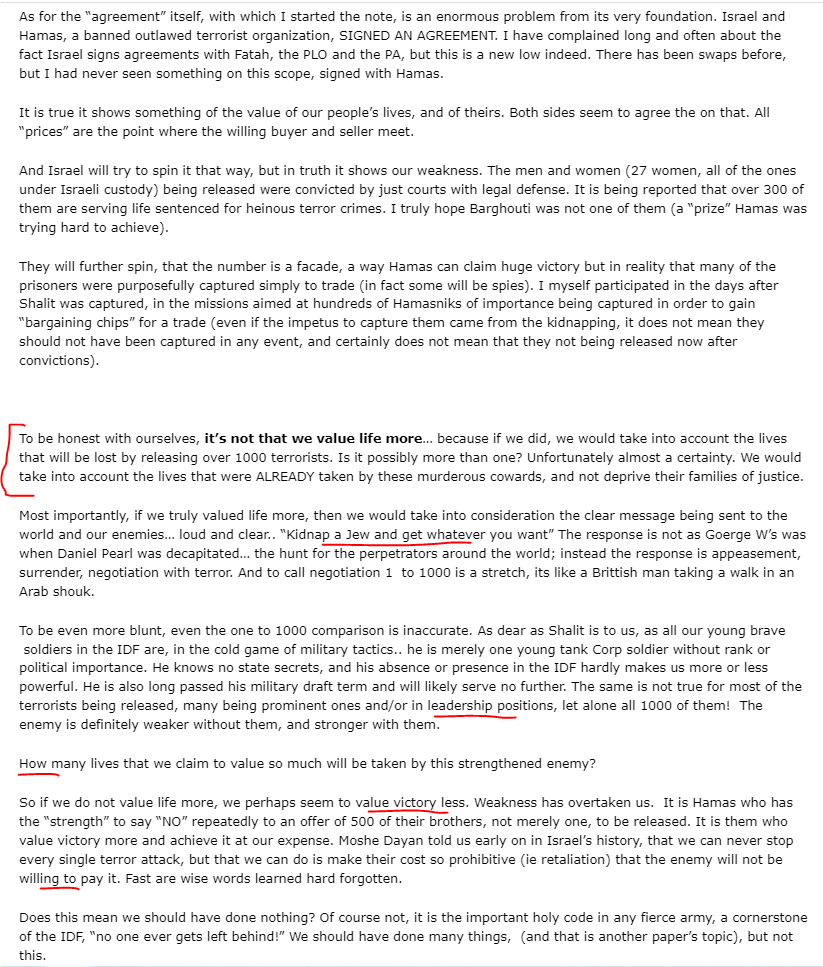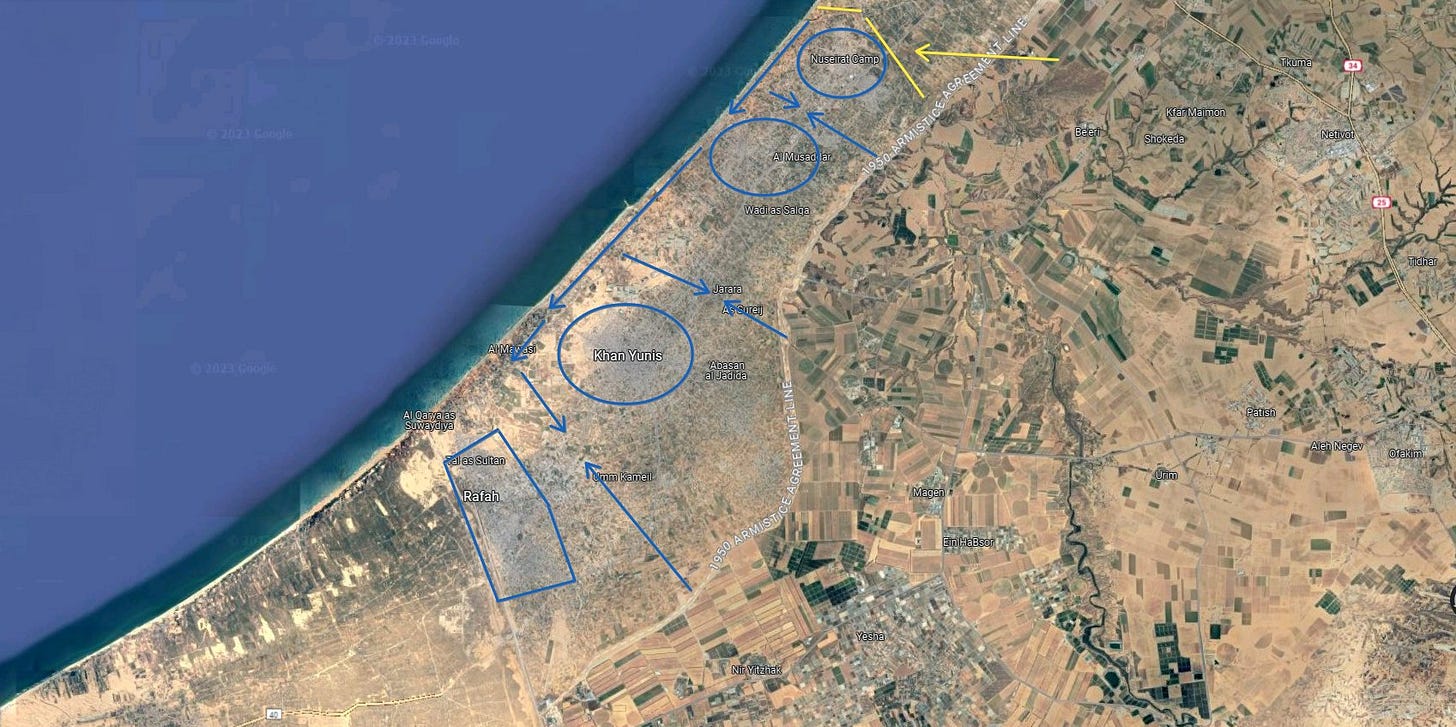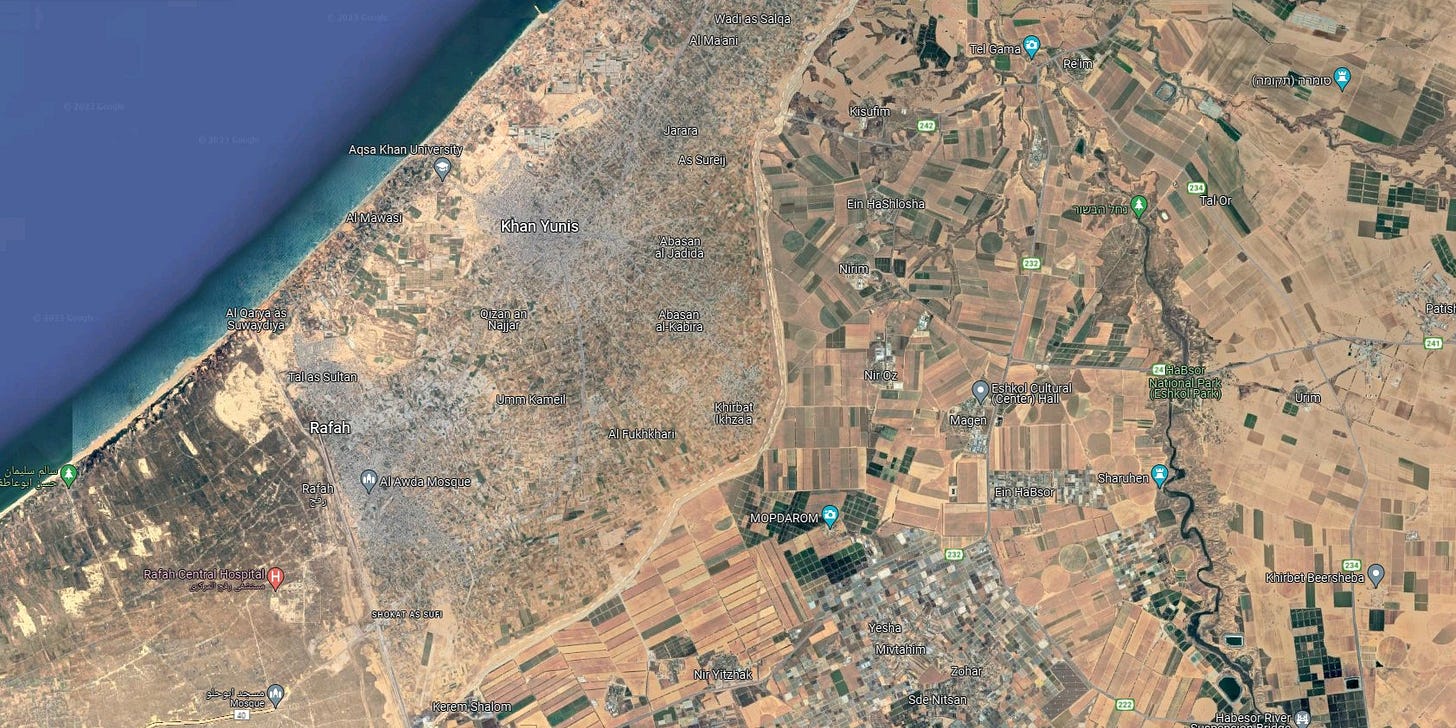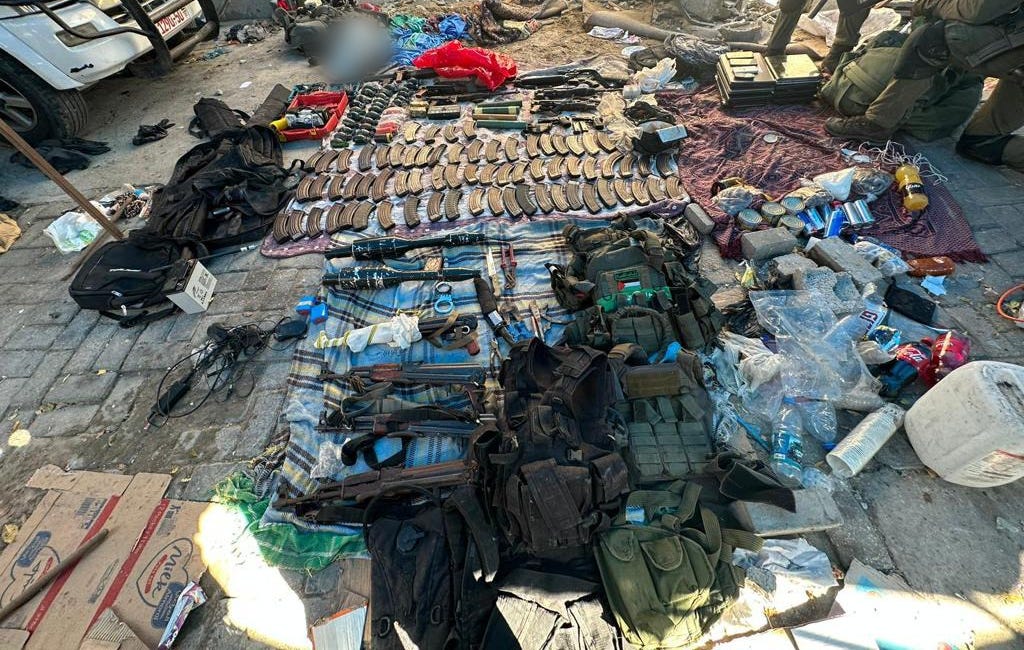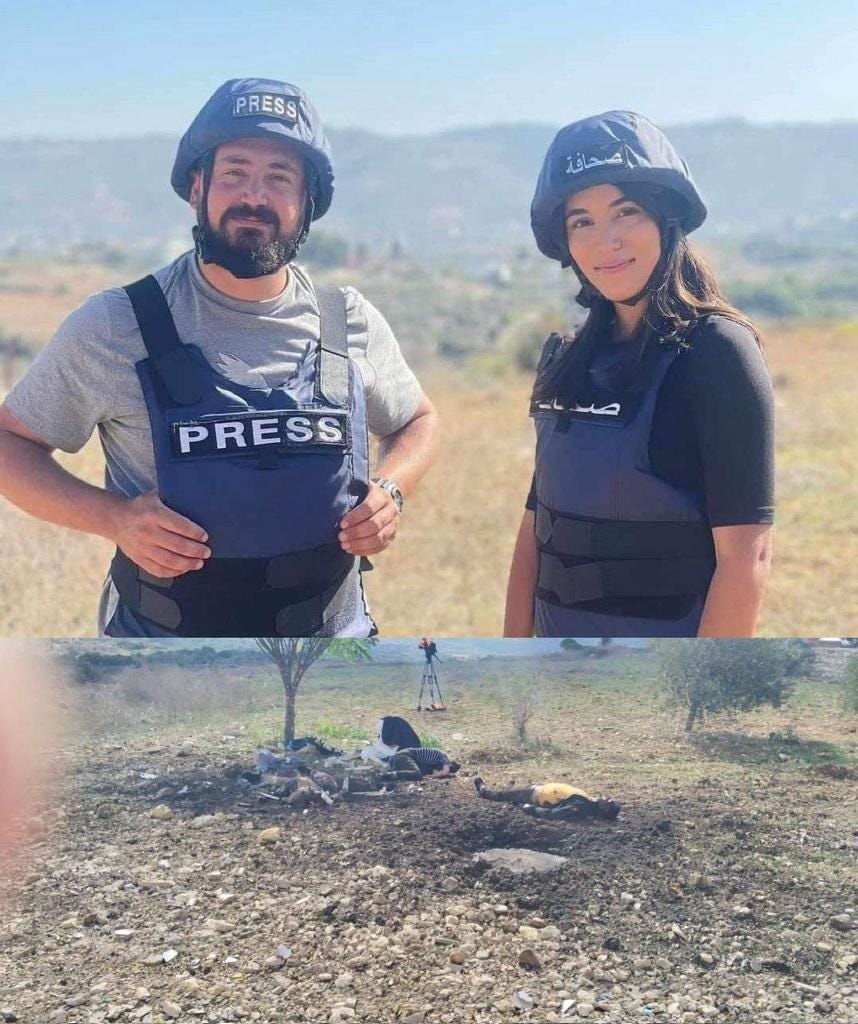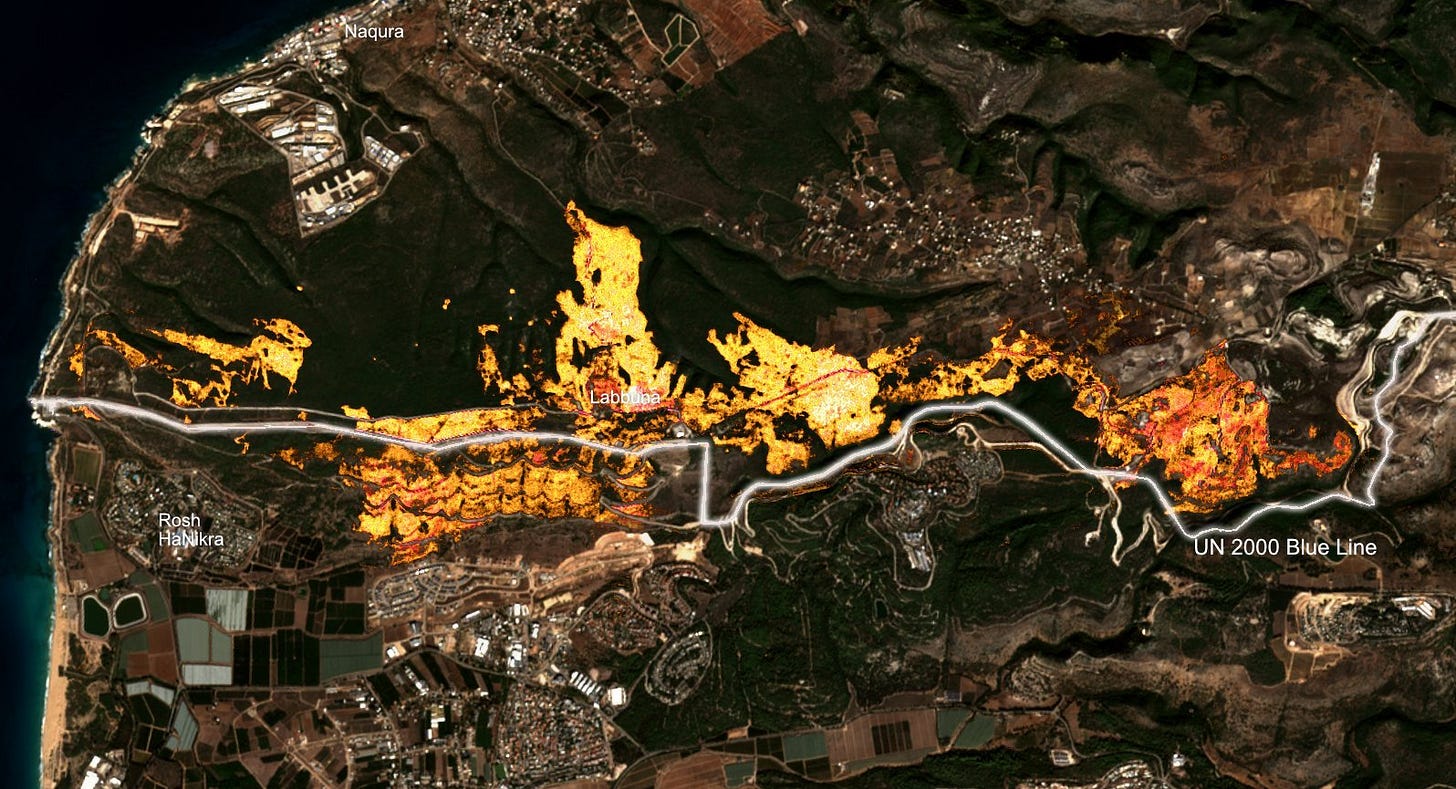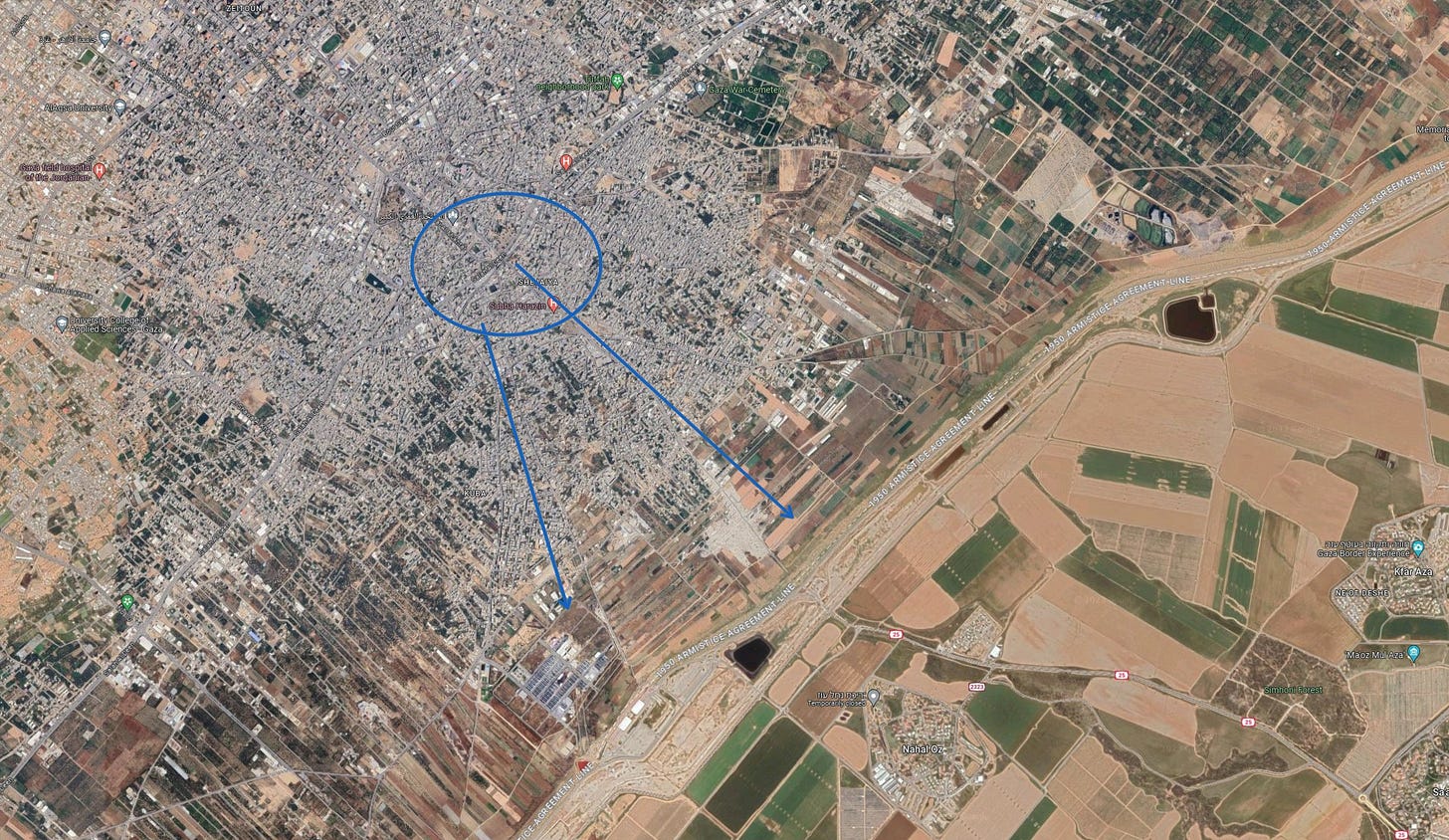2023 Israel Hamas War - Updates 3
See previous war updates here:
2023 Israel Hamas War - Updates 2
First Post: Sequel to be updated soon with updates and posts previously published (mostly on Twitter / X). Update 1 (original post https://twitter.com/ZimermanErik/status/1722997208784548070 on Nov 10 2023) 1 Month later... I knew the pictures would be different.
Update 1
original post Nov 16 2023
https://twitter.com/ZimermanErik/status/1725470999930392625
The IDF recently announced the death of a 19 year old hostage held by Hamas, Cpl. Noa Marciano. Today, the IDF announced recovering her body near Shifa Hospital.
Hamas had released a video of her, on the 13th, reportedly showing her testimony 4 days after abduction, and then
cutting to video showing her body.
The reporting surrounding the whole incident was odd. Without getting into all the details here, I believe what took place was a sort of explicit or implicit hostage execution threat.
Noa, likely like many of her fellow captives, were filmed by Hamas in the early days after their abduction. Hamas now has an archive of these videos to use for their psychological warfare activities. What may have happened is that they threatened Israel with her execution if the offensive did not halt. Israel did not halt, and so she was executed in cold blood.
In an ironic twist, both parties have no interest at this moment in the publishing of these facts. Hamas wanted to make their threats private and/or vague, as to not look like the terrorist organization it is to the progressive world trying desperately to save it from the IDF's ongoing operation in Gaza, which continues to advance despite international pressure to halt it. Additionally, choosing a soldier for execution would be somewhat more palatable than a civilian (Marciano was a 19 year old girl doing her compulsory 2-year service in an intelligence unit, a desk job ("jobnik" ) position far removed in any sense from a combat soldier).
So while Hamas did not (at this point) want to make that threat nor execution public, neither did Israel. If the public knew that the ongoing operation endangered Marciano, there would be large internal pressure to halt it. It would especially be used by Netanyahu's political enemies as a rallying cry for protests against him and the operation. And so, both sides kept this quiet.
Due to several statements by officials regarding the execution, and the vague reporting in Israel around it, it seems to me that this may have been what transpired. If so, we can expect further threats of executions as the noose tightens around Hamas' leadership and remaining forces. If so, it will be increasingly difficult to hide (for both parties) that this is what is going on.
However, there are also signs that not as many hostages as one would think remain in Hamas' actual control. The Hamas negotiators keep using any excuse to reduce the numbers, from an originally reported "near deal" at 100 to 80, 70 and now 50. Many hostages may unfortunately be already dead and/or not in Hamas' leadership control. Their best chance under an acceptable Israeli response (as Israel cannot or should not negotiate and appease the terrorist enemy, lest it encourages much more of the same as has been the case, which led to the very point we are now at).
This is an excerpt of a piece I wrote in 2011 on the Gilad Shalit deal (1,027 convicted Arab prisoners released for 1 kidnapped young man doing his compulsory 3-year army service. As I indicated in that sadly prescient piece, the leaders among the enemy prisoners being released would come back to haunt us.
Yahya Sinwar the current leader of Hamas in Gaza, himself was released by Israel in this exchange. As I described in more detail elsewhere, the only intelligent "negotiation" in respect to these terrorist tactics is to flip them on their head.
Local commanders and clan leaders should be contacted where possible. They must believe in the inevitability of the IDF's arrival.
We are taking all of Gaza. The tanks will be at your doorstop whether tomorrow, or in 1 week or 2 weeks. But they will be there. If the hostages under your command are alive and well, it will go well for you and your men (perhaps even freedom). If they are dead, it will go very poorly.
Not a negotiation with the leadership, and not a negotiation that rewards the kidnapping and threat of execution, but rather the opposite. This is the hostages’ best chance, and the appropriate response by Israel. The Hamas leadership will lose control of their forces, who are in at least some cases, made up of people who would like to stay alive, and free, as opposed to dead or arrested. Separately, monetary rewards for information should be offered to the population at large. Wherever possible, special operations should attempt their rescue.
Acquiescence to the terrorist demands however, paves the road to more death and our destruction. As the areas under Hamas control shrink, the complex hostage situation will increasingly come to bear on the Israeli leadership. They may yet surprise us for one and chose right.
Update 2
(original post Nov 16 2023
https://twitter.com/ZimermanErik/status/1725504978029027823 )
Israeli forces have strengthened their hold on surrounded Gaza city. The city is the most populous area of the strip, and the natural powerbase of the Hamas administration.
Using WarMapper’s (https://twitter.com/War_Mapper) map from a few days ago, we can expect IDF forces to advance from the recently captured costal region eastwards towards the heaviest Hamas fortifications.
Hamas' fortifications mostly faced east, expecting IDF incursions from the east (moving westwards). The IDF has operated contrary to this expectation to minimize casualties.
The IDF has been calling for any remaining residents in Shejaiya, Al Dera and Jabalya neighborhoods to move south along the humanitarian corridor established (along the Salah Al Din N-S main road) leading to the southern part of the strip.
Rather than move along a broad front through the densest of Gaza city which remains under Hamas control, the IDF is likely to attempt to further isolate the densest parts. By advancing along the Omar Al Mukhtar or Abdel Nasser roads (or similar), they can link up with their forces in the east and cut off about a third of what remains outside Israeli control. A similar maneuver can be done in an attempt to encircle the dense Jabalya area along the relatively more open spaces south and west of the Jabalia refugee market.
The relative ease in which Israeli forces took the dense Al-Shati camp (first encircled from 3 sides) along the coast shows this can succeed relatively well.
Once this is achieved a small central area of some of the densest central parts of urban Gaza city will remain. As I have written before, the tunnels need not be a focus. Shafts and access points need to be searched out and guarded/sealed (so that enemy fighter don't pop out behind your lines, cause casualties and escape underground once again), but other than that controlling ever more space above ground negates the usefulness of the underground. It cannot exist without space above ground... all it becomes is a death trap, which can be dealt at the leisure of the force that occupies the surface methodically. Sweater flooding, robots, dogs, special underground combat units, engineering forces, bunker buster bombs, high-tech sensors and another myriad of options exist to deal with them methodically.
The tunnels are a threat only while they compliment above-ground areas of control. Previous Israeli operations, suffering from the political aversion Israeli governments have had from advancing on enemy territory, suffered from an over-focus on the Hamas underground network, as we have discussed at length elsewhere and for a very long time.
I expect advance, as a matter of surface acres, to increase in speed in coming days as Hamas collapses as any type of coherent fighting organization in the north. Still, the IDF will continue to advance deliberately to minimize its own casualties, due to the complex and dense urban territory left to capture, and the myriad of IEDS, booby traps, mines, underground explosives and other such risks. Whole buildings are undoubtedly in many cases completely mined and very dangerous for units that enter them.
The question then becomes, what of the south?
The government seems to have set out for itself as an unconditional goal of the operation, the complete toppling if not dismantling of the Hamas administration over the strip. This will require taking the whole strip.
Even capturing 2 thirds and leaving the southern third, would leave a southern third under Hamas. Internal forces alone are unlikely to change that without the intervention of Israel, Egypt or some other force.
This leaves Israel with a strategic dilemma. The are south of Wadi Gaza are relatively open and will be relatively easy to capture. Nuseriat camp along with Bureji and Deir al Balah, do pose a challenge as dense urban areas, but their relatively small size and population, as well as the open territory between them means that they are less formidable as defensive positions since they can be isolated, and encircled with forces close to all points within.
Securing the relatively open spaces of the central strip, the south is what remains.
After Hamas has lost control over the northern strip, which is its stronghold, capital and largest city by far (estimated pre-war population of 740,000 people in Gaza city compared to 240,000 for Khan Younis and ~170,000 in Rafah), the south should pose an easier target militarily.
Not only are Khan Younis (or Khan Yunis) and Rafah smaller than Gaza city, but there is open space between them, allowing them to be encircled more easily.
The population in Khan Yunis will be asked to move further south as well towards Rafah and the Egyptian border. The city is a stronghold of Hamas, where many of its leadership hails from. The town boasts much poverty, high unemployment rates and some of the highest militancy in the strip.
IDF forces can advance along the open areas between the cities and along the coast, and encircle the remaining urban areas including Khan Younis.
After its capture the tricky questions begin. If Israel managed to take two thirds of the strip, and had much of the population move south towards Rafah and Egypt (as it already has), and stopped this alone would be a strategic achievement for Israel unmatched in many decades.
I have spoken elsewhere upon the strategic importance of territorial consequences. But no one wants to rule over people who do not wish to be ruled by you and vice versa. concentrated in the south, there would be greater pressures for their Egyptian brethren (as well as the Arab and Muslim world as a whole, and in fact the entire world as well) to accept willing emigres.
Pressure from Gazans who wish to leave may even overwhelm the Egyptian border, with or without tacit Egyptian approval. However, if the IDF continues to advance to Rafah as well, in order to complete the strip's capture and total elimination of the Hamas administration, it will potentially negate some of these achievements.
First, where would it tell the civilian population to go? Back north from where many came from? That would be undo the strategic achievement of their movement south. And if they go nowhere, then an attack on Rafah, would entail greater civilian casualties and further complicate the combat.
Gazans evacuate from the northern part of the Strip to south within the IDF safe corridor.
Furthermore, if Israel controls the entire strip, and becomes the ruling authority, even if only in security matters, then it will find it very difficult, once the fighting ended, to have a reason to not let people return to their homes in the north. Once again, the painful step which already happened, the movement of likely nearly 1 million Gazans further south and emptying of the northern strip, which is a security gain for Israel plus a source of the territorial consequence it should seek from this war forced upon it, a step which most Israelis would have thought nearly impossible just a few weeks ago, would be undone for no good reason and to the benefit of no one other than those who wish to perpetuate the conflict at any human cost for nationalistic reasons (which is fine by me).
Finally, on even a tactical level, Rafah poses a different challenge. The other cities, like Gaza city, may be surrounded by the IDF. This is critical for their successful capture. It also traps Hamas forces, leadership and any hostages in the area within the cauldron (unless the surface encirclement is not matched by an underground encirclement through the tunnels).
Rafah would be more difficult to encircle. The western urban area of the city runs along the Egyptian border. Advancing along the Philadelphia route would be trickier and expose a third party (Egypt) to potentially be embroiled in the fighting.
Without encircling it however, the area would remain open not only to the Egyptian border, and whatever can get in and out with Egypt's permission, but also though underground tunnels to whatever can get in and out without it as well. This would stiffen resistance and allow Hamas forces and leaders, along with their hostages, to flee the strip.
On a strategic level, cutting off any part of Gaza along the Egyptian border makes any civilian movement of the population to Egypt, whether with Egyptian open/tacit/secret approval or without it, less likely as now those people would have to "break" through IDF lines as well. Theoretically humanitarian corridors can be extended through the IDF lines towards Egypt, but they would not be the same as the pressure on the border that could be exerted without the IDF troops in the way.
So.. will the IDF continue to Khan Younis, I believe yes, we should soon start seeing the beginning of those maneuvers. Will they go on to Rafah as well? Not sure, and if they do, where will they expect the population to go, north, south or nowhere? And finally, will the IDF troops place themselves between the population and Egypt, a strategic error in order to gain the tactical benefit of cutting Hamas off from supply and escape routes.
Update 3
Original post on Nov 17 2023.
Al-Shifa Hospital & the PR Twilight Zone
Originally posted here: https://twitter.com/ZimermanErik/status/1725903839109243058 Ok let’s tackle this Al-Shifa hot potato. Regarding this ludicrous PR boondoggle, let me set the record straight. Or certainly attempt so. Israel is responding to the Oct 7th Hamas invasion of Southern Israel and subsequent massacre (within the briefly conquered areas), in a…
Update 4
Original post on Nov 20 2023:
https://twitter.com/ZimermanErik/status/1726954384003670132
Don't know if the casualties were truly press people (or even the claimed press people) or Hezbollah operatives.
However will say that in the case that they were truly press, the IDF did not target them intentionally. Anyone understanding the static war situation along the border would know however know the following:
To stand 2 to 3 km from the border (around Tayr Harfa) on a hilltop with camera equipment, facing and filming southwards towards Israel, while wearing helmets and vests is not very smart.
https://twitter.com/angeloinchina/status/1726922528134963385
The Tayr Harfa ridge is a strongly Shiite area, controlled by Hezbollah (unlike the small Sunni belt south of it along the border fence). Hezbollah regularly is shooting anti-tank missiles at Israeli positions (including a civilian home in Metula in the last 24 hours), and a static positional war has developed where small units try to identify targets (and each other). The casualties have been mounting on both sides though the IDF gets the better of the engagements.
Additionally, the channel al Al Mayadeen, whose team this was according to Lebanese reporting, is strongly Hezbollah and Iranian aligned, if not fully controlled. The director Ghassan bin Jiddo has spoken about this friendship with Hassan Nasrallah. Saudi Arabia (Sunni) has banned the channel from its satellite network. Variolous western reports cite it as Iranian funded. The ownership close to (or part of) the Assad family as well.
The channel was established in great part to counter the Sunni coverage of the Arab world's big players such as Al-Jazeera. It takes a strong pro-Assad, pro-Hezbollah and pro -Shiite stance in its coverage.
To have agents of such an organization, wearing vests and helmets, in Hezbollah controlled territory a couple of kilometers from the border (a virtually abandoned area since hostilities began), with camera equipment facing south towards Israeli positions, on the high ground is not foolhardy but courting death.
The team was pro-Hezbollah if not Hezbollah controlled in Hezbollah controlled territory dangerously close to the border in a war zone. It was likely either using the reporters as cover for recon against Israeli targets, or endangered intentionally by Hezbollah for the PR "points" of the IDF inflicting press casualties.
In the case it was truly acting independently, then it was foolish and unprofessional in its risk-taking, and Hezbollah at the least failed to warn and protect its own reporters.
Israeli reporters for example, cannot freely film into Lebanon from the high ground on the Israeli side. The IDF is controlling the area there and access strongly regulated for security reasons.
The northern border is a daily battle between hidden recon units, and forces using drones, artillery and anti-tank guided missiles. It is not a place where it is wise for a small group of people to stand on a hilltop with gear, and view/film their foe.
Increasing incidents like these, as well as the back and forth accusations, are leading the parties to outright war. Hamas started this round without Hezbollah's approval nor knowledge, it is in its interest to open a northern front. It is definitely not in the interest of Lebanon nor of the Shiites of south Lebanon to do so.
If cooler heads do not prevail, whether Israel has an intelligent post-war plan or not, the IDF will be unleashed into Lebanon.
Here, from Sentinel 2 data, we can see what the border area looked like already around a week ago. Advisable not to stand here. On either side.
Update 5
Original post on Nov 21 2023:
https://twitter.com/ZimermanErik/status/1726998623093764388
Despite the lack of available information (and thus most mappers not having updated their maps in several days), the IDF has made significant progress in the northern Gaza strip.
The advance from the coast eastwards (opposite of what Hamas defenses would have expected) continues into the most difficult and densest urban territory within Gaza city.
We have seen reports yesterday of fighting within and around the Indonesian Hospital. This implies a deep incursion from the Beit Hanoun area.
Likewise the 162nd Division (under Abraham "Bren" Adan during the Yom Kippur War it poured across the Suez canal, through the gap established by Sharon's Division, and raced southwards across the desert towards Suez city and surrounding the Egyptian 3rd Army), and the 36th Division (famously led by Raful during the Yom Kippur War, holding the line with the likes of Kahalani's battalion under Ben-Gal's 7th Brigade in the Vale of Tears) are spearheading this eastwards advance along at least two main axis.
Information has been tightly controlled, but there are indications that some pockets may be already closed. Gaza city will be further cut into at least 3 main pockets. These, which include the densest urban areas will be easier to then reduce piecemeal.
There are reports of heavy fighting in Rima and Zeitoun neighborhoods in recent days. Once these fell, the advance towards the center and further eastward would have been possible. In the northern sector, Jabalya is the main Hamas stronghold and it will be isolated.
The image shows the current and likely main axis of advance by IDF troops as they further reduce Hamas controlled Gaza city into smaller pockets.
These maneuvers have been playing out in a race against the clock as a pending hostage exchange ceasefire is likely to take effect. As I predicted early on in the war, Hamas quickly became uninterested in any hostage to prisoner exchange deal, regardless of the ratio or numbers involved.
These maneuvers have been playing out in a race against the clock as a pending hostage exchange ceasefire is likely to take effect. As I predicted early on in the war, Hamas quickly became uninterested in any hostage to prisoner exchange deal, regardless of the ratio or numbers involved.
The most likely deal, all children and women kidnapped by Hamas in exchange for all Arab women in Israeli custody would have been gladly accepted by our side (Israel). Hamas understood that this meant that the remaining hostages, men, both civilian and soldiers, offered no further value as human shields. Israel would pay any exchange price for the women and children, and then press on to Gaza's complete conquest and Hamas' destruction (at least within the strip).
So Hamas, as predicted, will only accept deals that include ceasefires. We can expect the prisoner ratio to not be that "crazy" relative to past exchanges (Gilad Shalit was freed in exchange for over 1,000 Arab prisoners, many of today's Hamas leadership included) and what was to be expected.
Rather than 50 hostages for 5000 prisoners, we can expect much smaller exchange ratios. What matters to Hamas is the ceasefire. It will likely be a temporary one, but will carry huge risk for Israel. Once a ceasefire takes hold, more of them are in store. As I have repeatedly stated, the only chance our foes have, is a ceasefire before our victory.
The deal is likely to be a strategic blunder by Israel, which could endanger the entire operation. It is also on principal (as I covered at length in earlier pieces) a mistake. However, I for one will be very happy to see any of our little ones back safely (as well as young women and anyone else freed).
I suspect the release will be agreed to in phases. The reason for this is surely Hamas insistence. They do not want to "pay", free hostages, in full before they got their ceasefire in full. especially since it is likely to be violated by both sides and thus fighting can resume at any point.
Secondly, I worry that Hamas may not have as many hostages, at least live ones under its control, as we may think. Many may be dead or not under their control. This is why they consistently reduced the numbers in the negotiations from 100 to 80, 70 and now latest numbers at 50, with even those released in phases. If for example, Hamas only had 30 live hostages, it could agree to this deal and still get most of its ceasefire. At one point it could just charge that it was violated or simply stop releasing any further hostages due to any excuse.
It will be doubly important for Israel to end the ceasefire and resume fighting promptly, at the earliest violation of the agreement and in any case at the end of the agreed upon ceasefire. It goes without saying that the ceasefire is to our enemy's benefit, and will allow him to rest, regroup, reposition and plan for for events going forward.
We pay for the ceasefire with soldier's lives, and extend the war's time more than linearly, not to mention hold the country's citizen army fully mobilized at great economic expense (myself included).
Hopefully, the terms will not be too dad, hopefully Hamas lives up to its part in releasing the hostages, and hopefully the pockets will have been sealed before the ceasefire. That way, Israel can use the days for thorough clearing of captured areas, troop rest & reorganization, and intelligence gathering and planning for the next phase.
Hamas and Israel's opponents will use it as the first step in ending Israel's ongoing operation far short of victory. It is up to the leadership to not break. Our enemy started this battle, but we must be sure to finish it.
If the above maneuvers were not completed in time before the ceasefire comes into effect, at the least we should have seen, highly dense Jabaliya (and Hamas stronghold) surrounded by IDF forces. The moves in yellow might indicate some of the subsequent movements.
After these, the isolated pockets will be cleared and Gaza city, finally under IDF control.
The coming days will tell us how far the 162nd and 36th Divisions got.
Despite the prepared dense urban environment, their large force, and vast support from Iran & elsewhere in the Muslim world, the Hamas fighters are completely outclassed and incapable of stopping the IDF advance. As I have been writing, only a ceasefire can save them.
We shall see if the one that looks imminent proves indeed to be only temporary, or their very salvation, delivered by Biden and his cronies, over a weak Israeli war cabinet made up of "centrists" whose very ideologies & conceptions led us to the October 7th massacre.
Update 6 (continues above)
Original Nov 22 2023:
https://twitter.com/ZimermanErik/status/1727293738634924514
And here we go. The truce, commencing 10 AM tomorrow, we are seeing the last maneuvers of the IDF to continue to close cauldrons, as we expected.
VIIRS data indicate the advance of the IDF. Previously defeating Hamas forces in the Zeitoun neighborhood, they advanced to the dense center of Gaza city.
Now there is the heart of Shejaiya neighborhood left, before the dense center opens up to more sparsely built up areas, and finally completely open and sandy territory until the Israeli border.
There is a very big tactical difference between the 4-10 days ceasefire with Gaza city center being left in whole under Hamas control, and being isolated into further cauldrons.
By cutting the remaining Hamas controlled areas into (hopefully) thirds, with Jabalya in the north surrounded, and this new line cutting across Shejaiya, the pockets will be untenable for the IDF's foes.
The regrouping, resupplying and refortification effort of the the Hamas, Jihad & other forces will be drastically impaired. We have seen already that when the surrounded pockets are relatively small, the territory falls into IDF control very quickly.
Hamas fighters are not the stuff of heroes, and feeling their escape routes cut off, they run, surrender or attempt to melt into the civilian population.
The race is on for key advances of the IDF before the ceasefire, which will in large part determine how much of a bad deal it is for the IDF forces.
In Hamas' publication of the deal details we can already observe important differences to what had been previously announced. Hamas for example, claims that the ceasefire prevents the IDF from arresting anyone in Gaza, and to allow freedom of movement of all their forces throughout the strip including north to (and from) south. This would effectively render IDF lines meaningless, as Hamas (presumably even armed) forces could cross them at will, and trapped Hamas leadership in the north could escape to the south (and subsequently potentially to Egypt).
This does not seem plausible, neither as something that Israel could have accepted, nor as something that can be implemented. It will likely be used as the inevitable claims and counterclaims of ceasefire violations that we will see in the coming days.
It will be important for Israel to finish the strategic advances, and hold those lines hermetically, while it uses the pause to search captured territory for foes, weapons and underground infrastructure.
If discipline is maintained, and Hamas not allow to bend on its commitments and draw out the ceasefire, IDF operations could resume in force within some days and finish the job.
Biden and the western media will exert all possible pressure to the contrary, in order to save the remaining Hamas regime and prevent an IDF victory. All of that of course, dressed up in humanitarian pleading.
Update 7
original post on Nov 24 2023:
https://twitter.com/ZimermanErik/status/1727836610576691465
The ceasefire starts in a few hours, 7 AM Israel time.
Hostages not to be released until 4 pm. There is speculation about what caused the delay.
My guess is that Israel had only agreed to begin the ceasefire with the first release of hostages. Hamas apparently then refused to abide by that, saying it could not release the hostages without a ceasefire.
They could be claiming that in order to find the hostages, collect them, move them etc, safely they would need the cover of a ceasefire (and especially the absence of IDF overflights which they demanded).
All of this strengthens the perception that Hamas may not have as many live hostages as we think, or at least not under its leadership's control.
It is possible it can't even produce the 13 women and children slated to be released tomorrow. On the other hand, it is possible it simply did not want Israeli drones to spot the movement of the hostages, giving away the position of the rest of them.
The cause of the delay was important enough for Hamas to allow Israel another 1 - 2 days of fighting, which as we discussed was crucial in finishing certain encirclement within Gaza city. We shall see how far the IDF was able to push by 7 AM tomorrow.
As we have discussed from the outset, a ceasefire is what Hamas desperately wants, since it is only hope. The numbers of palestinian prisoners being released is relatively small to what people would have thought previously. Early on there was talk of thousands, and even all palestinian prisoners (or at least all female prisoners) being released in the exchange. Ultimately, I believe the number are relatively small because Hamas doesn't care about that part of the deal anymore. It won't agree to release all the women and child hostages for all the prisoners in Israeli jails. Because then its human shield is gone, and its fate sealed.
On the other hand, it would gladly accept releasing all its hostages for a permanent ceasefire. Even without any prisoner exchange. Israel wouldn't accept. So what we have at the end is this temporary ceasefire which is the important part ofr Hamas. It believes it will be a stepping stone to a permanent ceasefire.
Israeli leaders, including Gallant, swore repeatedly that it is only temporary and that they would not buckle under international pressure, but rather continue the war after the agreed upon term. We shall see.
Something I hopefully can develop in more detail later, is the extent that Hamas is being broken. The anti Israel international pressure is mostly staged as humanitarian pleading. However, there are two sides fighting, and two ways the fighting can stop... that is either side can stop.
At the very least it makes sense to call on both sides or either one to stop, and that is if they are taken equally. One would think, many folks would call on the terrorist organization that rules Gaza to surrender, since it cannot win, started the war by its murderous surprise attack, and can spare Gaza much more destruction by its surrender. All parties know that if Hamas simply surrendered there would be no more death in Gaza.
Interestingly, such a call is unheard of from the West. We are told only Israel must stop before victory. Of course it cannot completely disarm or it would lead to the death of virtually all its Jewish citizens, so to "stop" means stop advancing, or even retreat to pre-Oct 7 borders, and remain armed and defend there.
Hamas on the other hand can surrender and disarm completely and the arab deaths would actually decrease rather than increase. That is an important and unobserved difference.
Why is this not heard?
Why is Hamas never called upon to stop fighting?
It started the fighting, comited atrocities, it is recognized as an illegal terrorist organization by many countries to begin with, and it continues to resist from within highly populated areas leading to civilian casualties.
So why?
Because those that disguise their politics as humanitarian wishes, want not to save palestinian lives, but rather to save palestinian sovereignty over the land, and likewise to avoid an Israeli victory.
They are not honest enough to say that. In any event, interestingly, before the ceasefire, we were hearing exactly such calls not from the West or its mainstream media, but from Arab sources. Arab states, and palestinian factions were striating to demand Hamas surrender. They see it cannot win and, actually caring about the destruction and death, called for it to stop the futile resistance.
Fatah even invited a disarmed Hamas to join the PLO as a political faction within the group. Similarly, in southern Gaza we see anti-Hamas rallies for the first time in years. Their hold on the remaining territory is weakening fast. Many correctly see what their government brought upon them (in western media you can whine about the response all you want, but in the Arab world they understand that if you kill and rape people's women and chidden, they will come back at you hard, especially when they are stronger than you).
Right at this moment Hamas is about to break, Israel unfortunately acceded to a ceasefire.
Hopefully the children and women will in fact be released, and the IDF will be allowed to continue onwards to victory, despite the pressure from the decaying (and invaded) Western European states and the Biden administration, which hopefully is itself on its last legs.
Follow-up:
One of the biggest tests for Israel and the IDF during the ceasefire will be to succeed in not to letting the civilian population return to the north. Gaza, city is not captured and if Israel intends to continue the war as promised, after the ceasefire, then it ought not to allow civilian population to return.
We are hopefully about to receive some our young children and women back.
I am sorry to think about the army of psychologists and social workers that will immediately acost them now and for years to come, causing more damage ultimately then even their current trials and tribulations.
Still will be very happy to see them back home and hope their parents and families learned not only some political lessons but also a healthy distrust of the authorities and powers that be. May they teach their kids to be strong and proud, far better than we are as a whole, so that their children, wives and mothers could never be taken as such again.



